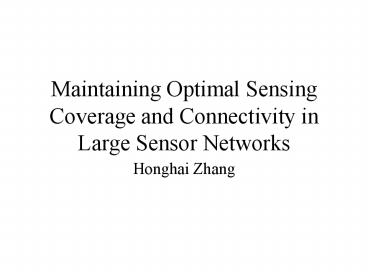Maintaining Optimal Sensing Coverage and Connectivity in Large Sensor Networks - PowerPoint PPT Presentation
1 / 16
Title:
Maintaining Optimal Sensing Coverage and Connectivity in Large Sensor Networks
Description:
Maintaining Optimal Sensing Coverage and Connectivity in Large Sensor Networks. Honghai Zhang ... not ensure connectivity. Ottawa work ... – PowerPoint PPT presentation
Number of Views:117
Avg rating:3.0/5.0
Title: Maintaining Optimal Sensing Coverage and Connectivity in Large Sensor Networks
1
Maintaining Optimal Sensing Coverage and
Connectivity in Large Sensor Networks
- Honghai Zhang
2
Introduction
- Sensor Network has two functionalities
- Sensing monitor environment, acoustic signal,
or electronic signal - Networking transmit the sensed signal to other
nodes - Additional Goal
- Use power efficiently, extend network lifetime
- Reduce message exchange for maintenance
- Assumptions
- Network is dense.
- Sensing range and radio range are different
3
Methods
- General Method
- Static scenario pick minimal number of working
nodes to fulfill the coverage and connectivity. - Dynamic scenario when a node is going to die,
wake up some sleeping nodes. - UCLA work (technical report), by Fan Ye, Gary
Zhong, Songwu Lu and Lixia Zhang - Ottawa work (WSNA02), by Di Tian and Nicolas D.
Georganas.
4
UCLA approach
- Each node has three modes sleeping, wakeup, or
working. - A sleeping node wakes up after sleeping for some
time. - When a node wakes up, it broadcasts a message
PRB. - When a working node receives a PRB message and is
within range r, it sends a reply. - When a wakeup node doesnt get a reply within
time Tw, it will start to work. Otherwise, it
continues to sleep. - Two design parameters
- Probing range r
- Wakeup rate ? -- decide how often should a node
wake up
5
Designing probing range r
- Given a desired density ?, design r.
- ? 1/S(r) , S(r) is the average area occupied by
each node. - Given probing range r,
- In the densest case, Sd(r)
- In the sparsest case, Ss(r)
- Average density ? (1/Sd(r) 1/Ss(r) )/2
6
Designing probing range r (cont)
7
Designing wakeup rate ?
- Given desired aggregate wakeup rate ?d, set the
individual wakeup rate ?. - Working node estimate the aggregate wakeup rate
?e, rebroadcast to each of its wakeup neighbor, - Wakeup node update its wakeup rate
- ? ? ?d/ ?e
8
Summary of UCLA work
- Concerns more on dynamic scenario
- Problems
- Assume all nodes have same sensing range
- Not ensure coverage,
- not ensure connectivity
9
Ottawa work
- Consider the coverage problem only (assume the
radio range is larger than sensing range) - Focus more on static scenario
- Ensure coverage
- Assume nodes may have different sensing range
10
Coverage Preserving
- When node i and js sensing range intersect, the
maximal sector of i that is also covered by j is
called the sponsored area by node j to i. - If a nodes sensing area is covered by all its
working neighbors sponsored area to it, then the
node can be turned off.
11
What we plan to do
- Explore some properties when nodes are optimally
chosen to cover the whole area. - Design algorithms based on those properties.
- Explore the relationship between sensing range
and radio range. - More usage on those relationships
12
Property 1
- Minimal number of working nodes ? Minimal
overlapping of working nodes, assuming working
nodes covers the whole area.
13
Property 2
- Assuming very dense network, in order for minimal
overlap, three nodes need to be placed with equal
distance d and d sqrt(3) r. - If the positions of two nodes are fixed, then the
third node should have equal distance d to the
other two nodes and d is only related to the
distance between the first two nodes.
P
B
A
O
R
Q
C
14
Relationship between sensing range and radio range
- The necessary and sufficient condition for that
whenever a convex area is covered then all nodes
are connected is, - Radio range gt 2 sensing range
15
Proposed Methods
- Assume radio range gt 2 sensing range.
- One or a few nodes act as the lead nodes that
initiate the process of finding the working set. - When a node hears the initiating message, it
delays time t1 to decide to act as a working node
and then broadcasts the initiating message - When a node hears two initiating message, it
delays time t2, and then broadcasts the
initiating message. - T1 and t2 are proportional to the nodes distance
to the optimal point but with some random effect.
16
Problems
- When does a node think it can sleep?
- It is covered by some other nodes.
- The most recent intersecting point is beyond its
sensing range. - How to do it in a dynamic scenario?
- Round by round, (adopted by Ottowa)
- Each working node remembers its neighbors, at
least the two closest intersecting neighbors, and
replies with such information to the wakeup
nodes.































